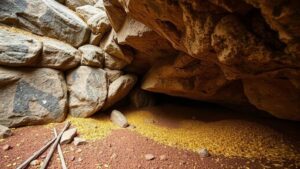The History of Dowsing Rods in Religious and Cultural Practices
The History of Dowsing Rods in Religious and Cultural Practices
Dowsing rods, traditionally known for their use in locating groundwater and minerals, have a rich history that intertwines with various religious and cultural practices across the globe. This article explores the evolution of dowsing rods, their significance in different cultures, and the intersection of dowsing with spirituality.
Origins and Early Uses of Dowsing
The practice of dowsing can be traced back to ancient civilizations, with evidence suggesting its use in cultures such as the Egyptians, Chinese, and Greeks. Historical records indicate that as early as 1500 B.C., the Egyptians employed a form of divination for locating water.
In 16th-century Europe, the practice gained traction, often referred to as water witching. This term was popularized due to the use of forked sticks or rods, typically made from hazel or willow, believed to point toward water sources. Also, many cultures regarded these materials as sacred, reinforcing the connection between nature and the divine.
Dowsing in Religious Contexts
Dowsing has not only served practical purposes but has also held spiritual significance in various religious contexts. In many cultures, it is viewed as a form of divination–a connection between the physical and spiritual realms.
- Christianity: Some Christian denominations have integrated dowsing into their practices, considering it a way to find holy water or sites of religious significance.
- Indigenous Practices: Various indigenous tribes in North America and Australia utilized dowsing for spiritual guidance and healing rituals, often incorporating natural elements that facilitated a deeper connection to their beliefs.
- Buddhism: In some Buddhist traditions, dowsing is believed to help locate missing objects or provide insights into spiritual journeys.
Modern Applications of Dowsing
In contemporary society, dowsing is embraced not only as a tool for finding water but also as a method for spiritual and psychological exploration. Dowsing rods are often used in energy healing techniques, where practitioners seek to detect changes in energy fields around a person or object.
Also, dowsing has seen a resurgence in interest due to its applications in environmental science and agriculture. For example, farmers may use dowsing to identify optimal locations for irrigation, while researchers study the effectiveness of dowsing alongside scientific methodologies.
Scientific Scrutiny and Skepticism
Proponents of dowsing, however, argue that the practice lies beyond the realm of measurement by scientific standards, tapping into intuitive and psychic abilities that cannot be quantified. This ongoing debate highlights the dichotomy between empirical investigation and experiential knowledge.
Case Studies: Cultural Significance of Dowsing
Several case studies exemplify the cultural importance of dowsing. For example, in rural Germany, dowsing has become a community tradition, with individuals bringing their rods to town fairs not just for practical applications but as part of local lore and social identity.
In another instance, among the indigenous Sami people of northern Europe, dowsing is integral to traditional practices, wherein the act is combined with storytelling, ensuring that ancestral knowledge continues to engage younger generations.
Conclusion: The Enduring Legacy of Dowsing Rods
The history of dowsing rods is a profound testament to humanitys quest for understanding water, nature, and the spiritual world. From ancient rituals to modern applications, the practice evokes a sense of wonder and a connection to the Earth. Whether viewed through a scientific lens or embraced as a spiritual tool, dowsing remains a fascinating aspect of human culture that reflects our diverse beliefs and practices.
As this tradition continues to evolve, it is essential to respect both its historical significance and the ongoing discussions regarding its legitimacy. Individuals interested in exploring dowsing should consider both historical context and personal experience, approaching the practice with a balanced perspective.



